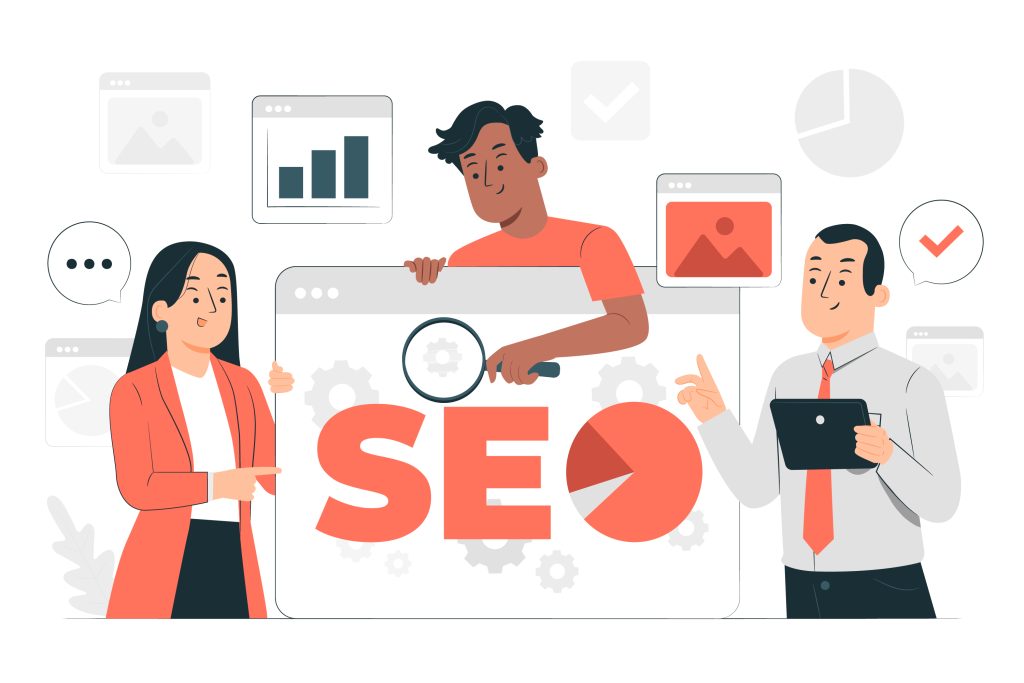In today’s hyper-competitive digital marketplace, your business’s online visibility can be the deciding factor between scaling success and stagnation. Search Engine Optimization (SEO) isn’t just a buzzword—it’s a foundational strategy for long-term business growth. In this article, we will explore how SEO helps your business, using real-life examples, recent statistics, and actionable insights tailored specifically for business professionals, entrepreneurs, and decision-makers.

1. Understanding the Basics: What Is SEO?
SEO refers to the process of optimizing your website to rank higher in search engine results pages (SERPs) like Google. It involves both on-page and off-page strategies to improve your website’s visibility and drive organic (non-paid) traffic.
Core Components of SEO:
- Keyword Research
- Content Optimization
- Technical SEO
- Backlink Building
- User Experience & Site Speed
According to a 2024 report by Moz, over 93% of online experiences begin with a search engine, and the first five organic results account for 67.6% of all clicks (Backlinko, 2023).
2. How SEO Helps Your Business Generate Quality Traffic
Unlike paid ads that stop delivering when the budget runs out, SEO delivers sustainable, long-term traffic.
Case Study: HubSpot HubSpot significantly increased its organic traffic by creating a massive library of SEO-optimized content targeting long-tail keywords. This strategy resulted in over 20 million monthly blog visits (HubSpot, 2024).
Benefits of SEO-driven Traffic:
- Higher intent users
- Lower cost per acquisition (CPA)
- Better engagement and conversion rates
3. Building Credibility and Trust Through SEO
When your business appears at the top of search results, users inherently trust it more. Google’s algorithm favors authoritative sites with relevant, high-quality content.
Real-World Example: Neil Patel Digital Neil Patel built trust in his personal brand by consistently ranking high for competitive marketing keywords. His SEO strategy led to a 12x increase in inbound leads in just two years.
Key Elements That Build Trust:
- HTTPS Security
- Authoritative Backlinks
- Helpful, expert content (E-E-A-T principles)
- Optimized user experience (mobile-first design, fast loading)
4. Local SEO: A Game Changer for Small and Medium Businesses
How SEO helps your business on a local scale is especially relevant for physical stores or service providers.
Statistical Insight: Google data shows that “near me” mobile searches have increased over 500% in the last five years (Google Trends, 2024).
Example: A Local Dental Clinic in Lagos By optimizing for “dentist in Lagos” and creating a Google Business Profile, the clinic saw a 75% increase in appointment bookings within 6 months.
Local SEO Must-Haves:
- Google Business Profile
- Local backlinks and citations
- Localized content and keywords
- Positive customer reviews
In this article, you’ll learn how to attract online customers to your local business
5. SEO Improves User Experience
Google now considers user experience (UX) as a ranking factor, making it crucial to ensure fast-loading, mobile-friendly, and easy-to-navigate websites.
Statistical Insight: According to Think with Google, 53% of mobile users abandon sites that take longer than 3 seconds to load.
UX-SEO Synergy:
- Page speed optimization
- Mobile responsiveness
- Clear site architecture
- Engaging and helpful content
6. Data-Driven ROI: Why SEO Is a Smart Investment
SEO is not just a cost; it’s an investment with measurable returns.
Statistical Proof: BrightEdge reports that SEO drives 1000 %+ more traffic than organic social media. Moreover, inbound leads from SEO have a 14.6% close rate, compared to 1.7% for outbound methods like cold calling (HubSpot, 2024).
Case Study: Ahrefs Ahrefs gets over 3 million monthly visits purely through SEO-driven content, with minimal ad spend.
Cost-Effectiveness of SEO:
- Long-term traffic with compounding returns
- Lower CAC (Customer Acquisition Cost)
- Scalable with consistent performance tracking
7. SEO Keeps You Competitive
If you’re not investing in SEO, chances are your competitors are.
Example: Shopify vs. Magento Shopify has aggressively used content marketing and SEO to dominate eCommerce search terms, significantly outpacing Magento in visibility and market share.
Competitive Edge with SEO:
- Dominate niche keywords
- Outrank competitors in search
- Stay top-of-mind for potential customers
8. Trends in SEO for 2025 and Beyond
Emerging Trends:
- AI and machine learning in search algorithms (e.g., Google’s SGE)
- Voice search optimization
- Video SEO (YouTube is the second-largest search engine)
- Featured snippets and zero-click searches
Action Tip: Start optimizing for conversational keywords and answer-based content to capitalize on voice and AI-powered searches.
Conclusion: The Long-Term Value of SEO for Your Business
From enhancing visibility to building trust and increasing conversions, the benefits of SEO are undeniable. This article has shown how SEO helps your business by drawing from the latest data, real-life examples, and emerging trends.
Key Takeaways:
- SEO is cost-effective and drives high-intent traffic
- Local SEO is vital for location-based businesses
- Optimizing UX improves both rankings and conversions
- SEO provides compounding returns over time
- Staying updated with SEO trends gives a competitive edge
Getting Started with SEO:
- Conduct an SEO audit of your website
- Use tools like SEMrush, Ahrefs, or Google Search Console
- Start with keyword research aligned with your business goals
- Optimize existing content and publish new, helpful articles regularly
- Build high-quality backlinks through guest posts and partnerships
By embracing SEO today, you invest in the long-term growth and sustainability of your business.
If you need digital marketing services, visit ebubenworie.com.ng
